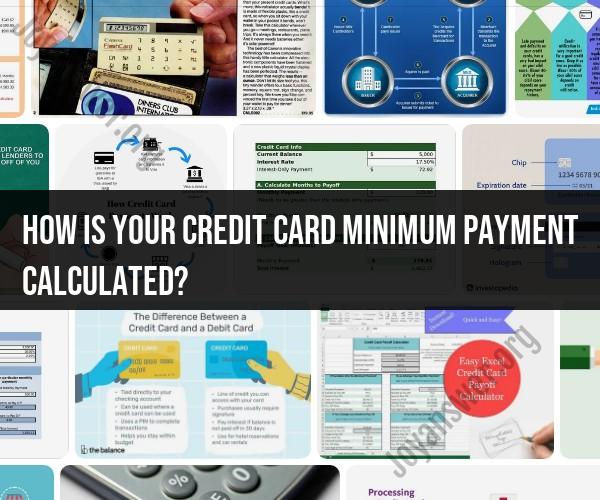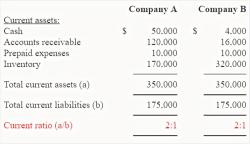How is your credit card minimum payment calculated?
Your credit card minimum payment is typically calculated by your credit card issuer using one of several methods, but the most common method involves a combination of factors, including a percentage of your outstanding balance, interest charges, and fees. Here's how your credit card minimum payment is generally calculated:
Percentage of Outstanding Balance: The primary component of the minimum payment is usually a percentage of your outstanding balance. This percentage can vary between credit card issuers and may range from 1% to 3% or more of your total balance. The exact percentage used is typically disclosed in your credit card agreement and on your monthly statement.
Interest Charges: Your credit card issuer may also include any interest charges that have accrued on your account since the last billing cycle. This means that if you carry a balance from month to month, a portion of your minimum payment goes toward covering the interest on that balance.
Fees and Penalties: If you incurred any fees or penalties during the billing cycle, such as late payment fees or over-limit fees, these may also be added to your minimum payment.
Floor Amount: Some credit card issuers set a minimum floor amount for the minimum payment. This means that even if the calculated percentage-based minimum payment is lower, you are required to pay at least the floor amount. For example, if the calculated minimum payment is $15, but the floor amount is $25, you would need to pay $25.
It's essential to read your credit card agreement and carefully review your monthly statement to understand how your credit card issuer calculates your minimum payment. Keep in mind that making only the minimum payment can lead to high-interest costs and an extended time to pay off your balance. If possible, it's generally advisable to pay more than the minimum to reduce your overall interest charges and pay down your debt more quickly.
Additionally, credit card issuers are required to provide you with information about how long it would take to pay off your balance if you only make minimum payments, as well as the total interest you would pay over time. This information can be eye-opening and motivate you to pay more than the minimum to expedite debt repayment.
Credit Card Minimum Payments: How They're Calculated and What Matters
Credit card minimum payments are the smallest amount of money you need to pay each month to avoid late payment fees and keep your account in good standing. However, it is important to note that making only the minimum payment on your credit card will not pay off your balance quickly and can lead to you paying more in interest over time.
Credit card minimum payments are calculated using a formula that takes into account your current balance, interest rate, and any other fees that may apply. The most common formula used to calculate minimum payments is as follows:
Minimum payment = (Statement balance - credits) * (Interest rate + Fees)
The statement balance is the total amount of money you owe on your credit card at the end of your billing cycle. Credits can include things like returns or payments you have made that have not yet been posted to your account.
The interest rate is the percentage of your credit card balance that you are charged each month for carrying a balance. Fees can include things like late payment fees, annual fees, and foreign transaction fees.
The Nuts and Bolts of Minimum Payments: Breaking Down the Calculation
Here is an example of how to calculate a credit card minimum payment:
- Statement balance: $1,000
- Interest rate: 10%
- Fees: $0
Minimum payment = ($1,000 - $0) * (10% + 0%)
Minimum payment = $100
This means that the minimum payment you would need to make on your credit card is $100. If you only make this payment, you will still owe $900 in interest and fees over the course of the year.
Cracking the Minimum Payment Code: Understanding How Credit Card Minimums Work
There are a few things to keep in mind about credit card minimum payments:
- Making only the minimum payment will not pay off your balance quickly. In fact, if you only make the minimum payment, you will likely end up paying more in interest over time.
- Credit card issuers are required by law to set minimum payments that are at least 1% of your statement balance, plus any interest and fees that have accrued. However, most credit card issuers set minimum payments that are higher than this.
- The exact formula that credit card issuers use to calculate minimum payments is typically kept confidential. However, it is believed that most issuers use a formula that is based on your creditworthiness, payment history, and credit utilization.
How to Avoid Paying Too Much Interest on Your Credit Card
If you want to avoid paying too much interest on your credit card, it is important to make more than the minimum payment each month. You can also try to transfer your balance to a credit card with a lower interest rate.
Here are some tips for avoiding paying too much interest on your credit card:
- Make at least the minimum payment on time each month to avoid late payment fees.
- Try to make more than the minimum payment each month to pay off your balance faster.
- Consider transferring your balance to a credit card with a lower interest rate.
- Pay off your balance in full each month if possible.
If you are struggling to make your credit card payments, it is important to reach out for help. There are a number of organizations that offer credit counseling and debt consolidation services.












